Hidden Gold | Vermont’s Best Little-Known Foliage Spots
As crowds flock to Vermont’s foliage towns this fall, there’s plenty of prime color to be found in surprisingly little-known spots, too.
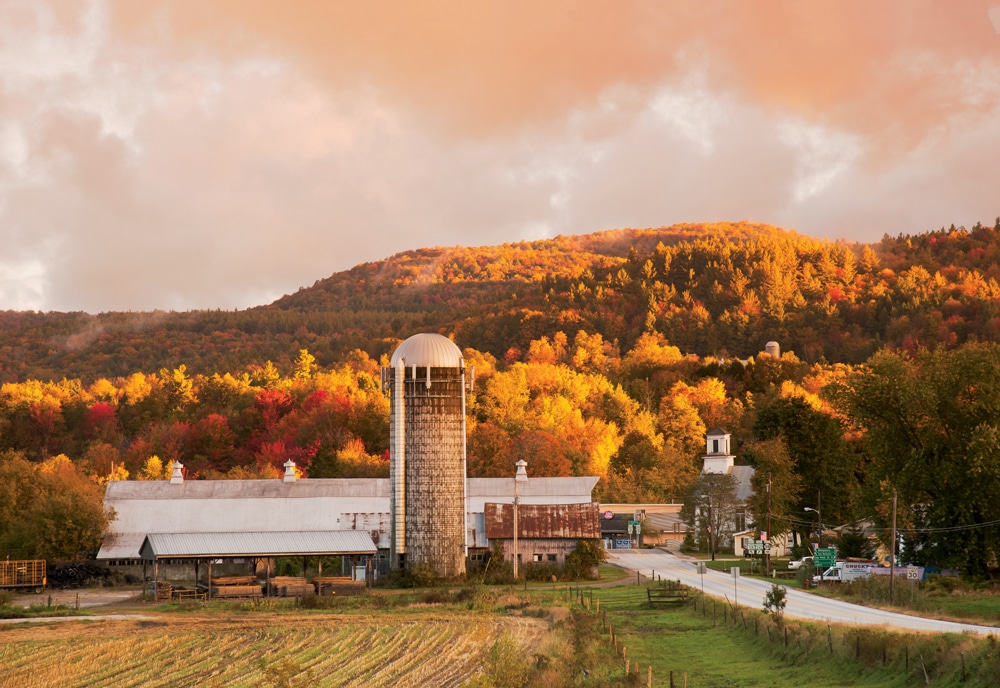
First light over the village of Montgomery Center, in Montgomery, Vermont—a town marked by winding roads, six covered bridges,
and big fall color.
There’s no need to get in line to see Vermont’s fall colors. You don’t have to hop onto one of the state’s main thoroughfares—Vermont’s “foliage highways”—and string together an itinerary that links one night’s lodging with the next. Nor is it necessary to book a weekend in one of the two or three top-tier destination towns and leaf-peep with the crowd.
Having peeped at a leaf or two in the quarter-century I’ve lived in Vermont, I’ve devised a third way to take in the colors: Pick a “base camp” from among dozens of smaller communities, stay there for a couple of nights, and explore your surroundings within a rough 25-mile radius. There’ll be less traffic, fewer people, just as much color … and maybe even a twisty little back road or an obscure historic site that few travelers know about.
Here are four of my favorites, from north to south. Of course, that’s the way the fall foliage display progresses, too—if you have a week or so, you can follow it along, devising your own route less traveled.

Photo Credit : Sara Gray
Montgomery
Although Vermont’s polychrome fall foliage didn’t get that way by being tie-dyed, there was a time when you might have thought such was the case in Montgomery. Located a scant eight miles south of the Canadian border, the town was a magnet for counterculture types back when the counter around which local culture revolved was a long marble one in a ’70s watering hole named Kilgore’s, after the Vonnegut character Kilgore Trout.
The saloon is no more, although its former home, a big Victorian ark of a building, still dominates Montgomery Center’s lone business block. The hippie aura is likewise mostly a memory, and today Main Street is home to two elegant hostelries, The Inn and the Phineas Swann Bed & Breakfast. Either might well serve as a base for exploring this corner of Vermont, where Franklin County’s dairy lands meet the forests of the Northeast Kingdom, all in the shadow of one very big mountain, Jay Peak.
If there’s one thing that shouts “Vermont” more than fall foliage, it’s covered bridges. Montgomery reputedly boasts the most of any town in the nation—six in all. I headed out early from Montgomery Center to look in on my favorite, the West Hill Bridge on remote Creamery Bridge Road (the town office has a map of all six, handy even for us locals), and found that it had been spiffily restored since I last saw it. No longer looking neglected and almost spooky, it wore its new wooden sheathing in calm contrast to the riot of surrounding color.
I was tempted to continue collecting covered bridges, but the new day and the fine weather called for more extensive wanderings. To get an overview of the terrain I wanted to cover, as well as sights a good deal farther afield, I rode the Jay Peak Resort’s aerial tram to the mountain’s nearly 4,000-foot summit. With vistas ranging clockwise from Quebec’s Eastern Townships to Vermont’s Northeast Kingdom to Mount Mansfield to Lake Champlain, the question became “Where to next?” I settled on Newport, at the southern end of border-straddling Lake Memphremagog.
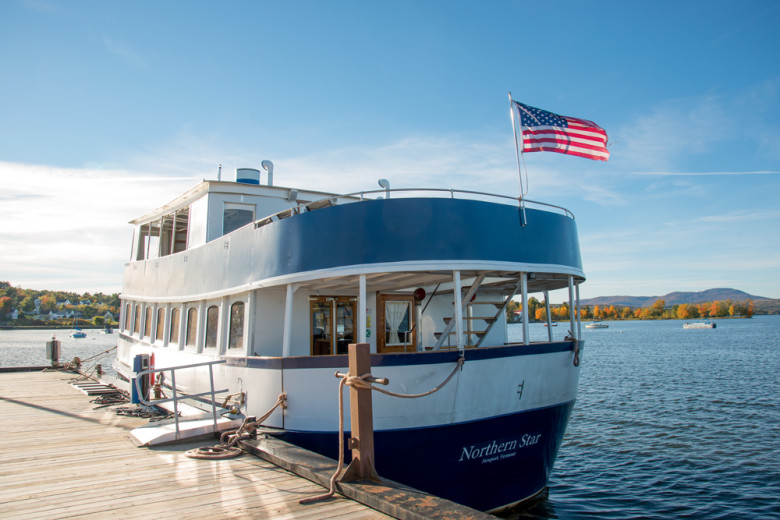
Photo Credit : Sara Gray
Newport’s boardwalk promenade brought me to the Northern Star and a 90-minute lunch cruise on the U.S. side’s only Memphremagog excursion boat. If there’s a more laid-back way to enjoy autumn’s panorama, it would have to involve an Imax theater. Later, I popped into the Northeast Kingdom Tasting Center downtown, where I took a glass-by-glass tour of local ice ciders and stocked up on fresh-baked cookies for a deliberately circuitous ride back to Montgomery.
That ride involved a jog down Route 100 and, at Lowell, a turn onto the Bayley-Hazen Military Road (Route 58). Named for a pair of Continental Army officers charged with constructing an invasion route to Canada during the American Revolution, the road never made it to the border—it was, the Yankees figured, too likely to become a two-way street. Today the stretch between Lowell and Montgomery Center is an unpaved tunnel through dense hardwood forests, reaching a nearly 1,800-foot crest at Hazen’s Notch. October is the last reliable month for traveling the old invasion road, as it closes when the trees give way to bare branches and winter white.
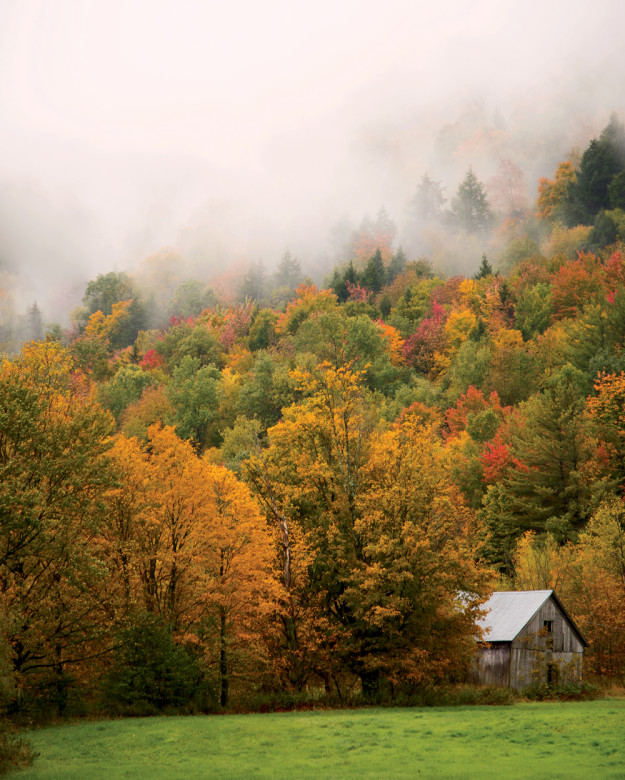
Photo Credit : Sara Gray
On my last day in Montgomery, I staged my own invasion of Canada, driving through the border crossing at Richford to the lively town of Sutton, Quebec. Here I found a cozy bistro, Le Cafetier, serving immense bowls of café au lait. At a gourmet food shop called Le Rumeur Affamée, I discovered a spectacular runny cheese, Epoisses Berthaut, beneath whose orange rind lies something that Brie might become if it were to grow up and take a worldlier attitude. With a bag of handmade bonbons from Chocolaterie Belge Muriel nestled next to my gearshift, I headed back to Montgomery and my pleasantly interrupted survey of covered bridges.
Lyndonville/Burke
I have to admit I was torn. I was, after all, in the mountain bike capital of New England, and the people at the Kingdom Trails office, in East Burke, assured me there were plenty of easy trails—marked in green on their map—that even a road biker like me could negotiate. And there was that rental center right across from the Wildflower Inn, where I was staying. But I decided I’d rather look up at the trees than down at the next bump, so I stuck to the roadways and footpaths in this sporty little shire.
I walked Darling Hill Road, past the old Darling mansion, a neo-Georgian banana cream pie of a building in yellow and white, and along pastures where Belted Galloway cattle grazed. The trimly bordered pastures, as well as the Quebecois cyclists gathered to visit the lovely, privately built Chapel of the Holy Family just above, lent a look of rural Europe to the scene.
For a taste of rougher terrain, I drove the two-mile toll road to the summit of Burke Mountain. From the platform that surrounds the terminus of Burke Mountain Resort’s highest chairlift, I looked to the northwest, where Mounts Pisgah and Hor cradle Lake Willoughby. Amazingly, I was alone up there, above so much color and under so vast a blue sky. I could think of more than a few other lofty Vermont vantage points where my immediate foreground view might have been of someone’s hat. And solitude, of course, meant that there were no mountain bikers around to make me look guiltily at my car.
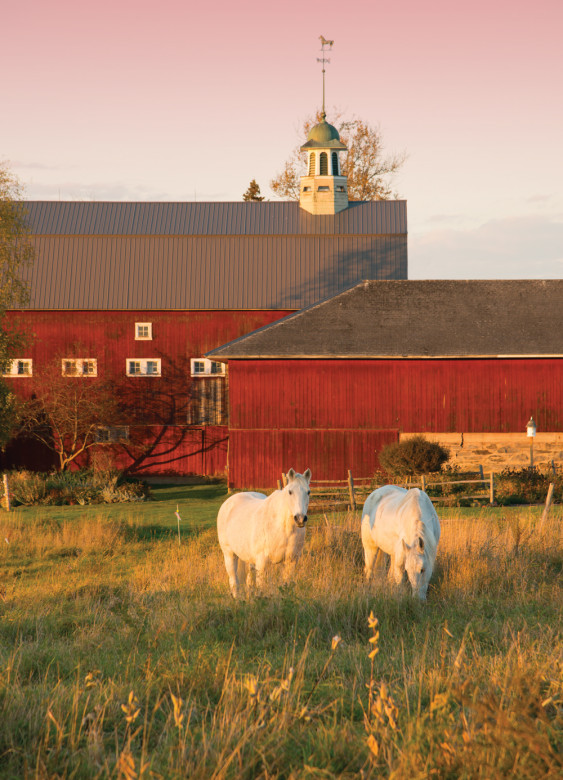
Photo Credit : Sara Gray
The next morning brought a light drizzle, but I knew just what to do when I found myself near Lyndonville in that sort of weather. Green Mountain Books and Prints, a couple of blocks away from the town green and its row of “painted lady” Victorian homes, is a delightfully cluttered trove of secondhand volumes. I got myself lost in there after an espresso at the nearby Grindstone Café, and didn’t come up for air until I glanced out the window and saw that the rain clouds were lifting.
I drove the 10 miles south to St. Johnsbury. If it had still been raining, I’d probably have hunkered down at the Fairbanks Museum and Planetarium or dropped into the St. Johnsbury Athenaeum to revisit its collection of 19th-century paintings. But under clear skies, I continued through town to Dog Mountain.
Dog Mountain is the crowning achievement of the late beloved artist, illustrator, and wood-carver Stephen Huneck. The property itself is crowned by the Dog Chapel, an intimate monument to a 30,000-year friendship between species. It’s dogs all the way in this little chapel, from the stained glass windows to the dog carvings at the end of each pew. Most poignant are the floor-to-ceiling photo tributes to bygone canine pals from their humans. And there he was, my old German shepherd, Max, posed on the edge of his meadow in all his dogly dignity. The picture was right where I put it two years ago.
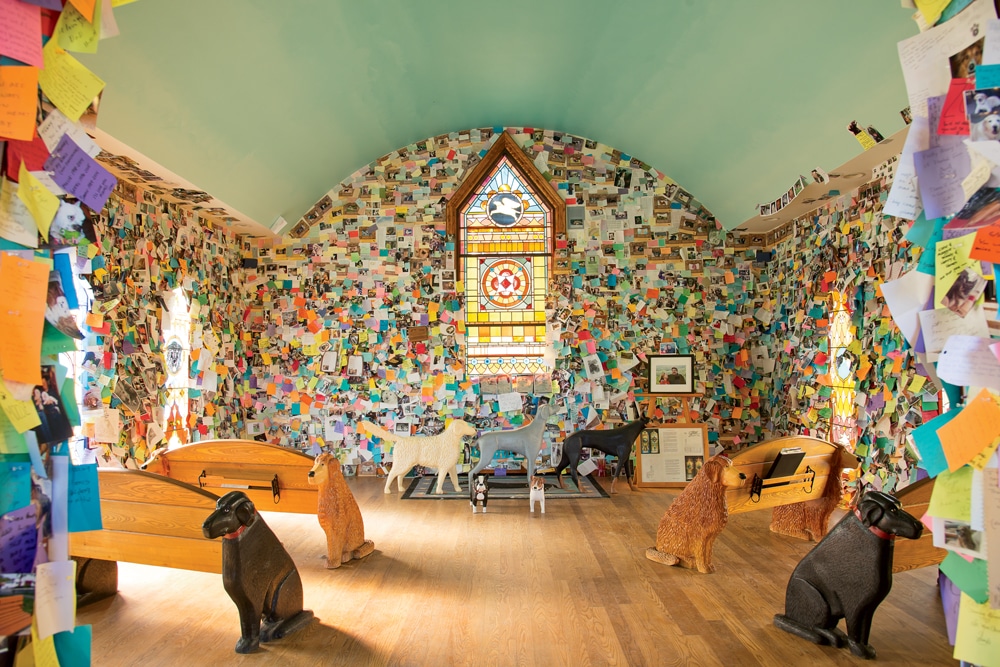
Photo Credit : Sara Gray
I left the chapel and walked up to the summit of Dog Mountain—a modest rise, really—and looked out over hillocks of orange, yellow, and vermillion that tumbled off toward the Connecticut River Valley. Max, autumn-born and autumn-departed, would have loved this October stroll.
Brandon
The Brandon Artists Guild knew what it was doing when it put rocking chairs on the business district sidewalks. These aren’t “art” rocking chairs. You can sit in them, and rock.
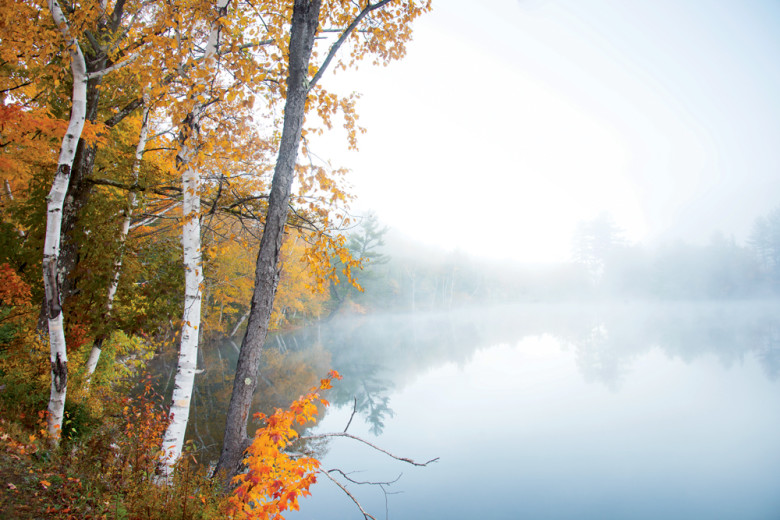
Photo Credit : Sara Gray
After dinner on a crisp fall evening, I stopped mid-saunter to park myself in one of the chairs as if I were on my own porch instead of a street corner. I watched Brandon go by, as shadows fell around the Civil War monument on the green, then strolled on to my lodgings at the Brandon Inn, one of the oldest continuously operating hostelries in Vermont.
For years I had thought of Brandon as merely a sharp bend in Route 7 between Middlebury and Rutland. But I learned just how unfair I’d been when I put up for a couple of days at the inn, and discovered a community where a two-chair barbershop and a hardware store share downtown with the artists guild’s gallery, a fine independent bookstore, and Café Provence, an upscale restaurant with an outdoor patio. Better yet, Brandon proved to be an ideal base for autumn explorations in almost any direction.
I started off with the requisite covered bridge—the Sanderson is right outside town—then meandered north via Routes 73 and 53 to the shores of Lake Dunmore, opposite which a Green Mountain National Forest trail leads to the Falls of Lana, a long series of sluices and pools turned into bright mosaics of fallen leaves and reflections of the ones still hanging on. I could have ascended farther, to pretty little Silver Lake, but the pull of history was taking me south and west of Brandon, to the one official state historic site I had yet to visit: Hubbardton Battlefield.
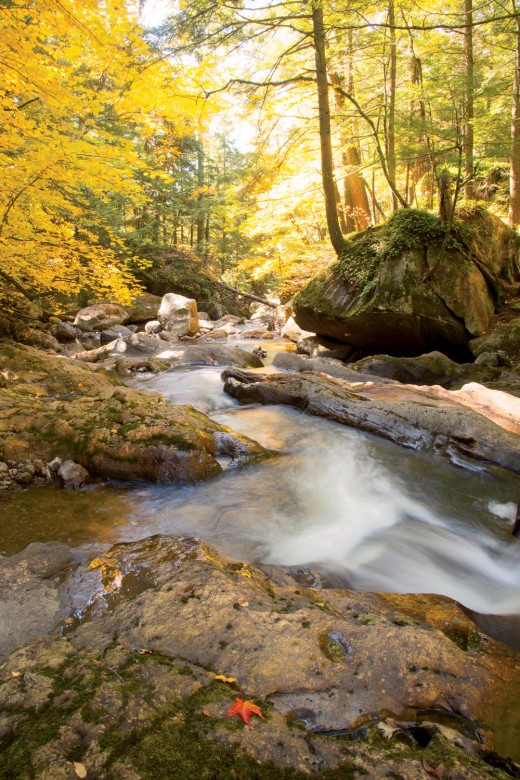
Photo Credit : Sara Gray
There are more direct routes from Brandon to Hubbardton than the one I took, but none is better for simply getting lost. High Pond Road, if you can find it, is a terrific excuse for ignoring what’s-her-name on the GPS and bumbling through a crayon-box autumn forest toward Monument Hill Road. When the vistas open up, that’s the rumpled northern verge of the Taconic Range ahead.
The battlefield, which Continental Army troops reached on an eastward march with far less regard for scenery, sprawls across a sloping meadow. Here, on July 7, 1777, they fought a rear-guard battle against their British and German-mercenary pursuers. The rebels were routed, but the enemy’s advance was slowed, and the stage was set for the battles of Bennington and Saratoga. I walked the field alone; battlefields are always more crowded with ghosts when you see them that way.
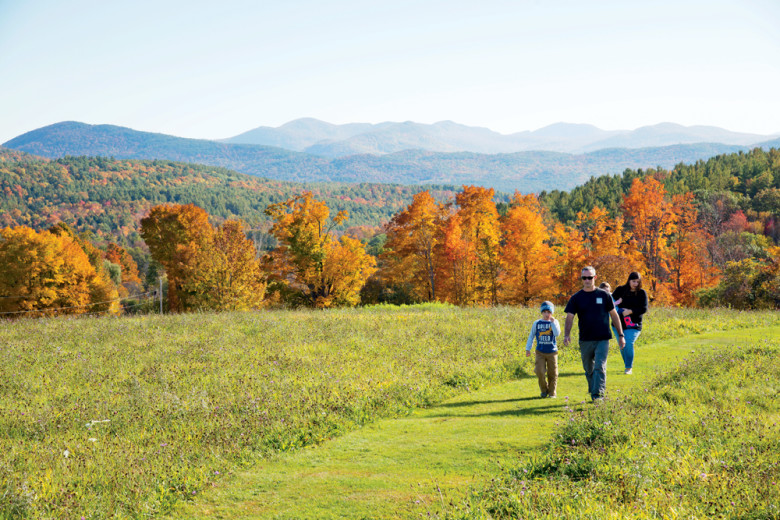
Photo Credit : Sara Gray
The next day, looking for scarlet in leaves rather than phantom redcoats, I headed southeast from Brandon to an out-of-the way corner of the national forest that cradles the Chittenden Reservoir and its small near-appendage, Lefferts Pond. I followed a trail that skirts the pond, a mirror for the bright hardwoods crowding its shores, while a lone kayaker shimmered the colors with the slow rhythmic dip of her paddle. Later, when I learned that a day pass at the nearby Mountain Top Inn gives access to a fleet of kayaks and canoes, I took to the water myself, on the vast reservoir.
And at the end of the day, there would be a comfortable rocking chair waiting for me.
Ludlow
That runny wedge of Epoisses Berthaut that I bought up in Sutton was all very well in its sophisticated way, but we Vermonters have to stand by our own versions of what Clifton Fadiman once called “milk’s leap toward immortality.” So when I chose Ludlow and environs as a tour base for foliage season, I knew I’d have to make a pilgrimage to nearby Healdville and the Crowley Cheese factory.
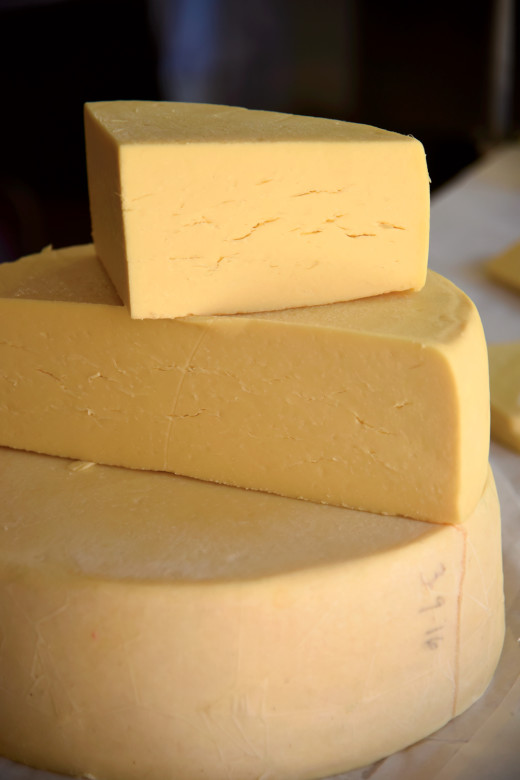
Photo Credit : Sara Gray
“We just finished making,” said a white-aproned woman as I walked into the modest shop in Crowley’s 1882 headquarters, the oldest continuously operating cheese-making plant in the country. “There’s just the four of us, and we’re sitting down for a while.” That gave me a few minutes to poke around the shop, where I saw that although jars of muffuletta and giardiniera had been added to the inventory since my last, long-ago visit, the staple was still the honest unpasteurized cheese that Winfield Crowley once made.
After buying a chunk—it’s quite similar to cheddar, though they don’t call it that—I kept up the dairy theme by heading back down Route 103 to Buttermilk Falls. Fallen leaves swirled in the pools that punctuate the falls as I made a lunch of cheese and the smoked sausage I’d bought at Singleton’s General Store, a must-stop in Proctorsville, on the other side of Ludlow, for anyone in need of picnic provisions (or a coonskin cap, a Hula-Hoop, or Vermont-made whiskey).
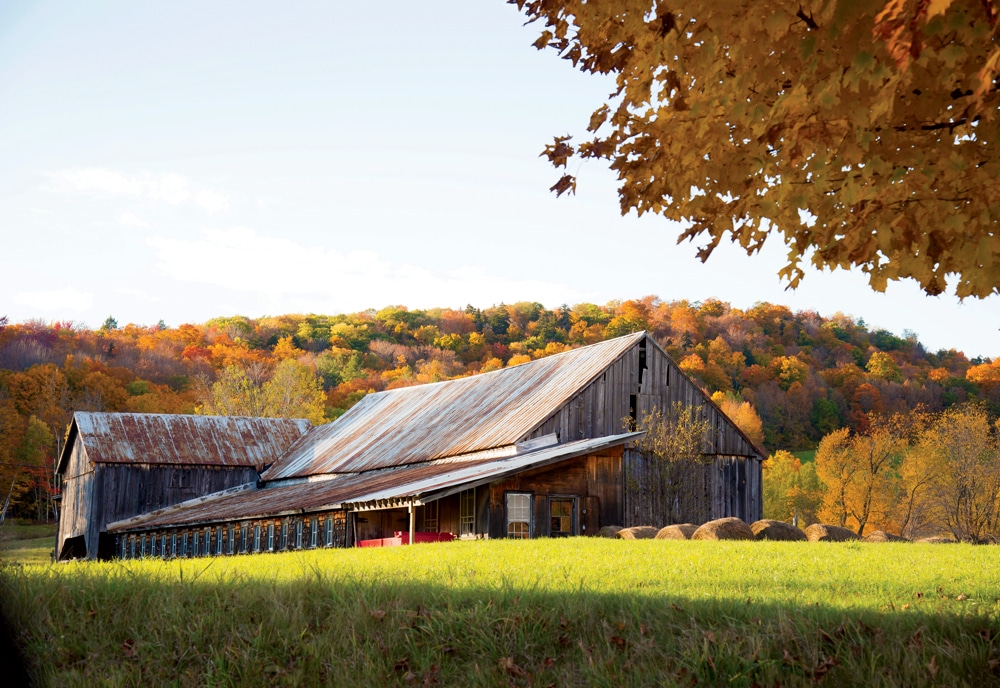
Photo Credit : Sara Gray
I made my Ludlow-area headquarters at Castle Hill, a resort that incorporates a grand stone mansion built at the turn of the 20th century by Vermont governor Allen Fletcher. This “castle” stands in sharp contrast to the home of another, better-known politician, whose life journey took him from a quintessential Vermont hill town all the way to the White House. As I drove the dozen or so miles north to Plymouth Notch, I thought about young Calvin Coolidge walking this route for weekends home from Ludlow’s Black River Academy. Home, of course, was his ancestral village of Plymouth Notch, where his father farmed and ran the general store.
I’ve visited the Calvin Coolidge State Historic Site enough times to know his story well. Coolidge may never rise above the middle presidential tier in scholars’ rankings, but his ascent from Plymouth Notch (not that he would have called it an ascent) and his father’s administration of the presidential oath of office by lamplight after Warren Harding’s death still resonate, and still make it worthwhile to look in at that little inaugural parlor. Fall is somehow a good season for visiting Plymouth Notch; the leaves gather on generations of Coolidge graves, and there seems to be a reminder that Coolidge’s time was the autumn of an old Yankee era in life and politics.
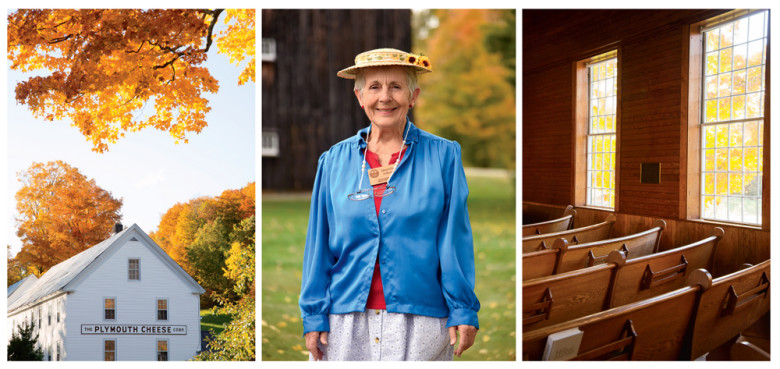
Photo Credit : Sara Gray
Mount Ascutney, east of Ludlow, in Windsor, is one of the peaks that Coolidge famously said moved him “in a way that no other scene could move me.” I finished my ramblings with a trip up the mountain’s state-run toll road, where a park ranger told me as I bought my ticket, “We have an undercast.” While I’d never heard the word, I quickly understood what it meant: I’d drive the lower part of the road surrounded by morning mist, but once up top I’d be rewarded with clear skies and a view of … morning mist, down below.
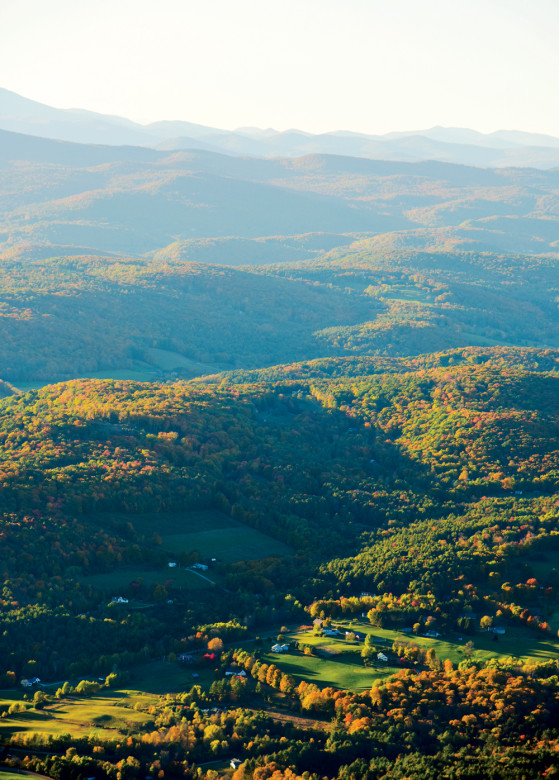
Photo Credit : Sara Gray
I parked at the road’s end and hiked the last half-mile to the summit lookout tower, and, sure enough, I’d arrived above the clouds. But I was in no hurry, and it was wonderful to watch the mists lift, patchily revealing farmland and vibrantly hued forest and the New Hampshire hills beyond the broad Connecticut River. Over on that other shore, I recalled, painters such as Maxfield Parrish, members of the Cornish Art Colony, once treasured their views of Ascutney. Through the rising mist, I felt as if I were looking back at them.
WHEN YOU GO
Montgomery
The Belfry: Busy little pub in a 1900s schoolhouse with burgers, pasta, and an impressively large specials blackboard. 802-326-4400; thebelfryvt.com
Phineas Swann B&B: Pristine (and pet-friendly!) Victorian farmhouse with glorious gardens and antiques-filled rooms. 802-326-4306; phineasswann.com
The Inn: Historic manor turned boutique hotel, with a hunting lodge ambience and innovative fine dining on-site. 802-326-4391; theinn.us
Lyndonville/Burke
Burke Publick House: Lively gastropub serving seasonal, local fare alongside a full lineup of regional brews and creative cocktails. 802-626-1188; burkepub.com
Miss Lyndonville Diner: Wallet-friendly favorite for breakfast classics and old-school comfort food. 802-626-9890
Wildflower Inn: Accommodations with country charm on a former dairy farm, plus field-to-table dining at Juniper’s restaurant. 802-626-8310; wildflowerinn.com
Inn at Mountain View Farm: Historic 440-acre farm turned B&B with 14 cozy rooms and suites, some with fireplaces. 802-626-9924; innmtnview.com
Brandon
Café Provence: Casually elegant French eatery that includes maple crème brûlée among its killer desserts. 802-247-9997; cafeprovencevt.com
Brandon Inn: Grand old Dutch Colonial–style inn on the village green with 39 rooms and suites, plus an outdoor pool. 802-247-5766; brandoninn.com
The Lilac Inn: Nine refined guest rooms (three with fireplaces) in a 1909 mansion situated on one of Brandon’s prettiest streets. 802-247-5463; lilacinn.com
Ludlow
The Downtown Grocery: Big-city excellence in a small town, with highlights including house-made pastas. 802-228-7566; thedowntowngrocery.com
Mojo Café: Inventive Tex-Mex and Cajun cuisine with lots of vegetarian options. 802-228-6656; mojocafevt.com
Castle Hill Resort and Spa: Ten luxury rooms in a c. 1905 stone mansion on a property that also includes rental condos and a hotel, the Pointe. 802-226-7361; castlehillresortvt.com
Echo Lake Inn: Victorian summer hotel that’s now a year-round lakeside retreat, with private dock, tennis courts, and pool. 802-228-8602; echolakeinn.com
Bill Scheller
Bill Scheller is a travel writer and journalist. He is the author of more than 30 books and is co-editor of the online travel magazine naturaltraveler.com. He lives in northern Vermont.
More by Bill Scheller

